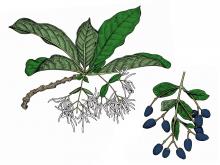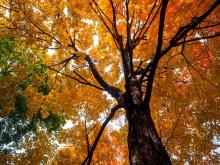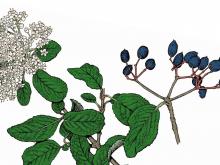Trees, Shrubs and Woody Vines
Media

Species Types
Scientific Name
Zanthoxylum americanum
Description
Common prickly ash is a thicket-forming shrub or small tree. Its compound leaves resemble of those of ash trees, but it’s in a different family. Pairs of stout, curved prickles occur at each node. Scattered statewide, but less common in the Ozarks.
Media

Species Types
Scientific Name
Cotinus obovatus
Description
American smoke tree is a tall shrub to small tree whose unusual flower stalks look like smoke from a distance. In Missouri it occurs naturally in the western Ozarks, but people use it in landscaping statewide.
Media

Species Types
Scientific Name
Chionanthus virginicus
Description
White fringe tree is a shrub or small tree that is native to southwest and southeast Missouri. Its fragrant, showy clusters of white, drooping, fringe-like flowers make it a popular for landscaping.
Media

Species Types
Scientific Name
Dirca palustris
Description
Eastern leatherwood is a native shrub of bottomlands, stream banks, and bases of bluffs. It has unusual little dangling yellow flowers, and its twigs are surprisingly flexible.
Media

Species Types
Scientific Name
Juniperus ashei
Description
In Missouri, Ashe’s juniper is uncommon and only found in a few southwestern counties; our populations represent the northeastern tip of its range. Here, it is much less widespread than its close relative eastern red cedar.
Media

Species Types
Scientific Name
Acer spp.
Description
Missouri has five species of maples that are either native or naturalized, plus several that are known only in cultivation. Maples are important members of native ecosystems. They also provide stunning fall color, welcome shade in summer, commercially important lumber, and sap for syrup.
Media

Species Types
Scientific Name
Callicarpa americana
Description
American beautyberry is a many-branched shrub that bears attractive rounded clusters of purple berrylike fruits in the axils of the leaves in late summer and fall. A critically imperiled species in Missouri, it is also a popular native shrub for landscaping.
Media

Species Types
Scientific Name
Viburnum rufidulum
Description
Southern black haw is an irregularly branched shrub with shiny, dark green, opposite leaves whose lower surface is paler with scattered rusty hairs, especially on the veins. It bears clusters of white flowers, which turn into bluish-black fruits.
Media

Species Types
Scientific Name
Rubus occidentalis
Description
Black raspberries resemble blackberries, but when ripe, the fruits fall away as a caplike unit from the receptacle. Leaflets appear white underneath. The canes are whitish-coated when young; they arch down and take root at the tips. Native and scattered statewide.
Media

Species Types
Scientific Name
Ulmus spp.
Description
Missouri has seven species of elms that grow in natural settings. Elms have tough, shock-resistant wood. In the past, some species were favorite shade trees, which is why so many towns have Elm Streets. But elms have suffered for a century from a devastating fungal disease.
See Also
About Trees, Shrubs and Woody Vines in Missouri
There are no sharp dividing lines between trees, shrubs, and woody vines, or even between woody and nonwoody plants. “Wood” is a type of tissue made of cellulose and lignin that many plants develop as they mature — whether they are “woody” or not. Trees are woody plants over 13 feet tall with a single trunk. Shrubs are less than 13 feet tall, with multiple stems. Vines require support or else sprawl over the ground.





















